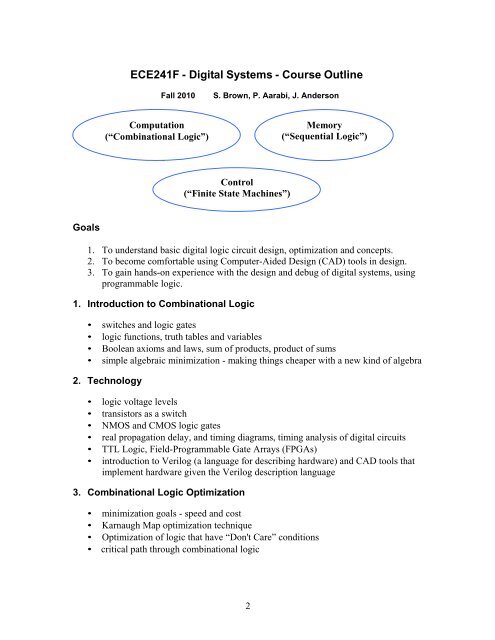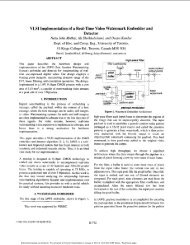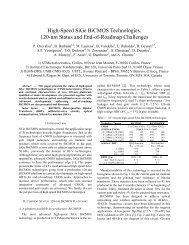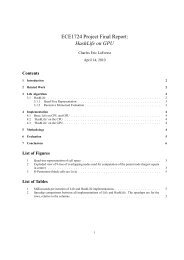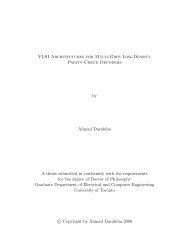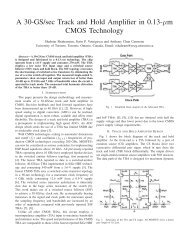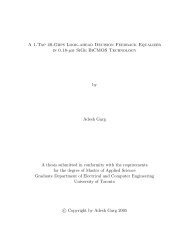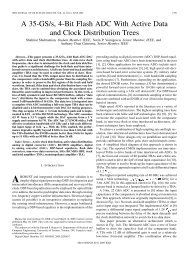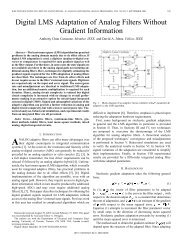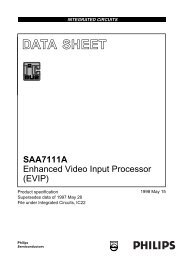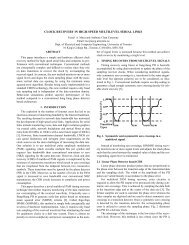ECE 241 Digital Systems
ECE 241 Digital Systems
ECE 241 Digital Systems
- No tags were found...
Create successful ePaper yourself
Turn your PDF publications into a flip-book with our unique Google optimized e-Paper software.
<strong>ECE</strong><strong>241</strong>F - <strong>Digital</strong> <strong>Systems</strong> - Course OutlineFall 2010S. Brown, P. Aarabi, J. AndersonComputation(“Combinational Logic”)Memory(“Sequential Logic”)Control(“Finite State Machines”)Goals1. To understand basic digital logic circuit design, optimization and concepts.2. To become comfortable using Computer-Aided Design (CAD) tools in design.3. To gain hands-on experience with the design and debug of digital systems, usingprogrammable logic.1. Introduction to Combinational Logic• switches and logic gates• logic functions, truth tables and variables• Boolean axioms and laws, sum of products, product of sums• simple algebraic minimization - making things cheaper with a new kind of algebra2. Technology• logic voltage levels• transistors as a switch• NMOS and CMOS logic gates• real propagation delay, and timing diagrams, timing analysis of digital circuits• TTL Logic, Field-Programmable Gate Arrays (FPGAs)• introduction to Verilog (a language for describing hardware) and CAD tools thatimplement hardware given the Verilog description language3. Combinational Logic Optimization• minimization goals - speed and cost• Karnaugh Map optimization technique• Optimization of logic that have “Don't Care” conditions• critical path through combinational logic2
4. Sequential Logic• cross-coupled NOR/NAND gates basic latch• gated latch• Master-Slave D flip-flop• shift registers• counters• Set-up & hold time, clock-to-Q5. Finite State Machines• how logic is controlled• state diagrams• Moore-type state machines• State machine synthesis• State machines in Verilog• state encoding and optimization6. Numbers and Arithmetic• number representation, binary, ones & twos complement representation ofnegative numbers• basic adder/subtracter• carry look-ahead methods for fast addition• bit serial addition7. Miscellaneous• multiplexors & tristate gates• multiplexors as logic; decoders• fanout-dependent delay• power dissipation, I/O devices and FPGAs• Static Random Access Memory (SRAM);• Controller for digital display• De-bouncing mechanical switches• VGA display interface3
<strong>ECE</strong><strong>241</strong>F - <strong>Digital</strong> <strong>Systems</strong> - Lab Schedule and InformationFall 2010S. Brown, P. Aarabi, J. AndersonThe real learning in this course goes on in the laboratory where you design, build and testand fix real circuits. There are seven mandatory labs of three hours each, and so you willhave one 3- hour lab every week. You will work in groups of two.There is also a project based on the material of this course that you will also work withyour partner on. As an alternative to the project, you may choose to do two extra labs.You are encouraged to do the project instead of the labs, and there will be a prize for thetop project.There are two parts to the lab experience: preparation, which you must do outside of thelab hours, and the actual implementation of circuits in the lab.PreparationEach lab usually requires you to do significant amount of preparation, and is where youmust do much of the work to understand the concepts. Preparation must be completebefore the lab begins. Preparation will usually require design using the CAD softwaresupplied. Each partner in the group of 2 must perform and submit a separatepreparation. While it is acceptable to discuss your preparation with your partner, yourwork may not be copied from your partner; you will be required to explain yourpreparation. Please be aware that severe penalties will be imposed for copying of labs, asevidenced by an inability to explain the work given as preparation. It will be graded bythe TAs at the beginning of the lab, on the following basis:Judgement of TAGradeUnable to explain any part of preparation 0Some merit to work 1Made a legitimate attempt 2Reasonable job, may be some missing things 3-4Correct and Done well, demonstrated clear knowledge of subject. 5In-Lab WorkIn each lab you will typically have to build a working circuit. Once this is done, foreach such circuit, show it to your TA for grading, out of 3:Judgement of TAGradeDid not attend or try 0Tried, but failed to get much working 1Most, but not all working 2Everything worked 3Note: Although the lab portion of the course is worth only 12%, both the midterm and thefinal exam will contain questions directly related to skills learned in the lab.4
Lab Workstation Number and MaintenanceEach digital workstation that you’ll be sitting at has a number. Please use the same stationeach week. If a piece of equipment is not working, please tell a TA to tag the board withthe problem and notify someone to have it repaired. Otherwise it will be broken the nexttime you need to use it!Lab Sections, Day Time and LocationSection Day Time Location(s)1 Monday 3-6pm BA 3135 & 31452 Tuesday 2-5pm BA 3145 & 31553 Friday 10am-1pm BA 3135 & 31454 Monday 9am-12 BA 3135 & 3145Lab and Project Schedule for 2010Date of MondayLab#1: Building simple logic functions using 7400-series chips.September 13September 20September 27Self-guided tutorial in the lab with Quartus II and theDE2 board. No marks for this lab. TAs will beavailable to assist you.#2 Lights, switches, multiplexersOctober 5October 11October 18October 25#3 Numbers and displaysThanksgiving week -- no lab; midterm exam this week!#4 Latches, flip-flops and registers#5 Counters and clocks#6 Adders, subtractors, multipliers#7 Finite state machinesNovember 1November 8November 15 Project or Extra Lab Period 1November 22 Project or Extra Lab Period 2November 29 Project or Extra Lab Period 35
The TaskThe purpose of the project is to:<strong>ECE</strong> <strong>241</strong> ProjectFall 2010 S. Brown, P. Aarabi, J. Anderson1. Gain experience dealing with the design of a larger digital system, and to dealwith the issues in going from a soft simple specification (“make a digital toastercontroller”) to an actual complete design. There is no substitute for experience!2. Express your creativity by applying what you have learned in this course to aproject of your own choosing.You will design and implement a project of your own choosing that uses digital logic insome creative way. You may use any of the parts available in the lab, but are restricted tousing just one of the Altera DE2 boards. An important part of this lab is the creativityrequired to think up an interesting project, and then negotiate with a TA or instructor asto the final form of the project.Originality/Uniqueness ApprovalThe first step in your project is to come up with an original idea. You must submit youridea, in a 1-3 line description, via email to your <strong>ECE</strong> <strong>241</strong> instructor for “originality” or“uniqueness” approval. The instructor will quickly respond to tell you if the idea hasalready been proposed more than once. If it has, you'll have to come up with somethingdifferent. Please note that this approval is only the first step and only deals with the basicidea, and not the scope/effort required for the project; that comes next:Before the First Project labYou will submit a short project proposal of what your project is about. This should be ashort description that gives:• The basic idea of the project, and the basic function of your circuit.• Describe the inputs and outputs, and give a simple block diagrams describing howthe various parts of your circuit interact.• Your plan of action for each of the three lab periods - "milestones"• Present this to your TA to get their opinion on whether the project is viable.Once approved, you should get their signature. This is just a check to makesure that you do not try something overly ambitious.Demonstration and ReportYou will demonstrate your project to your supervising TA in the final lab period, and willbe required to provide a short report describing your project.7


